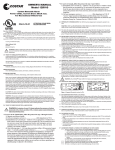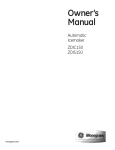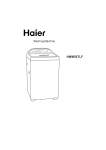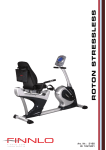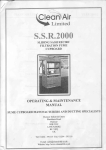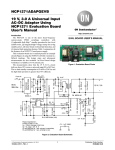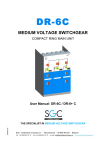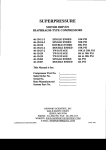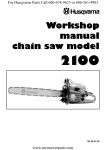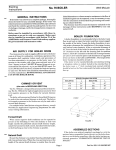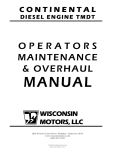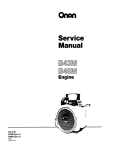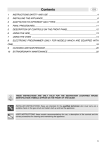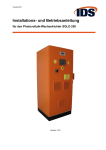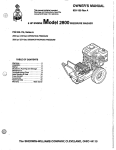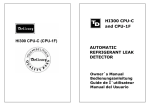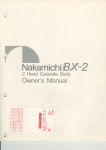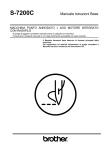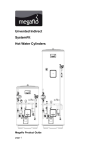Download Process Ball Valves Manual
Transcript
INSTALLATION, OPERATION AND MAINTENANCE MANUAL FOR AIL SINCLE PIECE & TWO PIECE FULL BORE BALL VALVES 1.0 STORAGE OF VALVES On receipt. check rhe valve to cnsure that it is in full-v assembled condition and in the open position. End protectors on thc valve should be kept itttact and removed only at the time of installation. \"alvc performance dependson prevention of damage to the ball,'seatsurfaces. V'alvesshould be stored in a covered arca. If covered area is not ar.ailableany water proof covering material should be sprea<ior.er the valr.es and they should be kept on a u.ooden pallet at least l50mm above the ground ler.el. Do not apply tar. paint. greasc or any other ntaterial inside the valr-c or on the stcnr.as this could impair the performance of valve. 2.0 INSTALLATION 2.1 GENERAL When despatchcd.r'alvescontain a rust prcventor and if necessarymay,-be removed rvith a solvent. Before installation cnsurc that thc pipcline has be-en flushed on line scale. rr'cld spattcr. rust and othcr foreign mattcr. Ensurethat the end protectorsare removedat the time of installation. 3. 0 OPERATION 3.1 GENERAL AIL Ball valvesprovide bubble tight shut off rvhen used in accordancervith our publishedpressure/ temperaturechart. It is not the right practiceto leave the valves in a partiallyopen(throttled)positionas this can damage the seatsand adr.erselyaffect its performance. Any mediathatmay solidify.crystalliseor polymerise shouldnot be allou.edto rcmain in the rralvecavity as it can affect the operationof the valve. 3.2 MANUALOPERATION AIL Ball valveshavea quarterturn operation.closing in a clocku'isedirection.It is possibleto determine rvhenthe valve is open or closedby the positionof the ler.er.When the lever is in line rvith the pipeline, the valve is open.and u'hen at 90o to the pipelineit is closed. REMOTEOPERATION When manualoperationis not desired,valvesmay be automatedfor remoteoperation.A rangeof pneumatic/ electricactuatorsand gear units are availablefor mountingon AIL Ball valves. unit No stopperplateis fitted on actuatedvalves/gear valves.as the stop is normallya part of the actuatori gear unit. For operationaldetails of thc actuators,refer to installationmanualof the actuator. 4.0 MAINTENANCE 4.1 GENERAL AIL Ball Valves have a long trouble free life. and is seldomrequired.But rvhennecessary. maintenance valr.esmay be refurbishedr.ery easilyby using feu' u'hichdo not requiremachiningat site. components. AIL Ball Valves are designcdfor easy serviceand a s s e m b l yi'n f i e l d . T h e f b l l o u . i n g p o i n t s r v o u l d . ho*,ever,help to extendvalve lif-efurtheqor reduce operationalproblems. 4.2 STEMLEAKAGE Remove the rvrcnch assemblv.Exarninethe disc springs(BelleVille'Washer- applicableupto40mnr) for damage.lf in eractcondition.tightentheglandnut If damaged. until thediscspringsarefully compressed. dismantlethe stem dou.n to the gland. fit nerv disc springsrvith thcir outer edgestouchin-eand tighten requires using a ne\\' cland nut. Furthern:aintenance dismantlingof the valve. If the stem leakageis not arrestedbir the above procedure.dismantlethc vah..e.Hott'e\.erdo not disturb the stem assemblfif no stem leakageis noticed. 4.3 ]N-LINETHROUGHLEAKAGE C'heckthat the valve is fully closed condition. If it is, then the leakage is possibly' due to a damaged seat/ ball or sealing surfaces and it s.ill be necessary to dismantle the valve to rectify it. 4.4 REFURBISHING Usc only genuine AIL Ball \'alve spares. These can be ordcred on our distributorsand authorisedstockists. Parts of r.alves fiom dilfercnt sizes of seriesmust not be interchanged. This is irnpor-tantas it ensuresthat the valve is capable of bein-r.used for the purpose it r.vasdesigned and constructed and operatcd without risk to health and safctl.'. 4.5 SAFETYPRECAUTIONS Bcfbre removitr-uthe valve fiorn the pipeline. enstrrc that adequatesaf-etyprecautioltsare taken, as the mcdia floiving through the valve may be corrosive. toxic. inl'lammable or contantinated. It is advisable to use shields, gloves anci safety shoes. safcty gear like e-"-'e Ensure that bcfbre rerpoyin_ethe r.alve firtrn the line no pressureexistson the upstreamor domlstream sides of the r-alve. Before rentttvitrg thc valre cnsure that any trapped media is rclcasedb1'openingthe valrc sloil'l-vto half open position. i^,tench i\jut @- SranE vliasier Sloc P'r 3:3nd Nu:: Berle!:lje v"r3hers Gi?na GiandPac(ing- Slefi Th.us: Sea' _-bs Explodedview of Ball valve 'l5mm to 40rnm 5 iirenc\ ;rx'nE Eoli i'irenct Fead Siaqc fiul Lrcki4g Clip 3land Nui Slco ind,calor Gl3nd Clandoac(nE Siea Lmatioi Ring Seccidan/ Sten Seal Bodv:cnnectol 3c'ew Seat Rrng - Sail Seal Rilg Slefl:hrrsl Seal Sler Explodedview of Ball valve 50mm and above 4.6 DISMANTLING Removethe valvefrom the pipelineby extractingthe flangebolting from eachend. Largepipelines(srzes 80mmandabove)har.ea tendencyto springtheflanges and removalcan be difficult. If necessaryremove e l b o r v s .c o u p l i n g so r p i p e s u p p o r t st o g e t e x t r a maneuverability. The valvecanbe removedin eitherthe openor closed position. Hor.vever, if it is open.it ensuresthat no line media lies pressurised rvithin the vah,e car.ity. With ther.alvesecurelyclamped(r'crtically,insertside f-acing thetop)andin theopenposition.undothe insert usingtheappropriatedrive adaptor.It may benecessary to use a heavy n-ralleton the tommy bar of the insert tool to breakthemetalto metalsealandmovethe insert initially. Removethe inser-tto allow accessto the cavity.Thc insertshouldbe remor.edout of the body completely as otherwise its seal face may be damagedlnot applicablefor 2 piece design). In caseof 2 piecedesign.removethe interconnecting bolts betrveenbody and body connector. Remor.ethe body sealanddiscard.Ifthe sealis difficult to renlovethan use a scriberor sharpbladed scrervdriverand dig into the body sealat an anglefar enoughto pror.idepositive location.Lever out one sectionof the sealfrom its recessandpull it out using a long nosepliers. Closethe ball and usinga soli drift throughthe body port. tap out the ball and insert seat. Turn the stemback to thc open positionand using a suitablehook pull out the body seatbeingcarefulnot to damagethe seatsealingface and the fire safelip on the l.all.e body'. To dismantlethe stem assembly'removethe rvrench nut, rvasherand rvrench from the stem. Using the rvrenchto preventthc stentlrom turning,removethe gland nut and the gland. Tap the stem dou'n and rvithdrau.it from insidethc body.The glandpacking, o' ring and the stem sealcan now be removedfrom (from 5Ommonu'ards).beingcarefulnot theirrecesses the seal faces. to dan-rage All componcntsmust bc inspectedfor u'ear and Partsthat are not to be replacedshouldbe dama-sc. thoroughly cleanedand stored in a clean area.All sealingfaceson the body. insert and ball must be If dan-rage checkedfor corrosion.erosionandscratches. doubt.replacethe component. is foundor thereis an1,' Cleariingof valve parls sliould be carriedout using a suitabledegreasinuagent.Hard depositscan be remor,edusingu'ireu'ool or by usinga hardblunt tool. Careshor"rld be takcnnot to dantageor scratchan.vof faces and machinedfaces. the seal 4.7 REBUILDING B e f o r c r c b u i l d i n e .c h e c k t h a t a l l t h e c o r r e c t componentsare availableand thc,vare fit for the is essentialto \\"henrebuildingcleanlincss plrrpose. allow long valve life and provide cost effective maintenance Fit the new gland packinginto the body recess,the gland and new disc springs(with their outer edges touching)onto the stem.This is applicableonly upto 40mm size. Fit the gland nut, pre\.entthe stem from turning and tightendou'nto fully compressthe disc springs(only upto 40mm size). Fit thervrench,rvasherand rvrcnchnut to the stemand operatethe stem to the valve open position. Securethe valr.ein a verticalltosition.rvith insertside facingupu'ards(upto40 ntm) or body connectorfacing upu,ards(from 50mnr& above).With the body seat endon,enterit into thevalvecar.itvpastthestemdrive tang.then positionit into the seathousing.A silicon basedgreasemay be appliedto thc seatface to aid bedding in of the r.alve. Turn the stemto valr,eclosedand slide the ball into the body locatingthe stem drir.e rang. Havin-qapplied silicon greasefor sizesupto 40mm locatethe insertend seatinto the cavity and the body sealintothehousing.For sizes5Ommandabove.locate the body connectorend seatinto the car,ityand bodv seal in to the housing. Open the valve and scrervthe insert for sizes upto 40mm into thevalr.ebody usinga suitabledrive adaptor for sizes50 mm & abovebody connectorshouldbe put into the body and tighten the fasteners.It is importantthaton stainless steelvalvesan anti scuffins compoundis usedon the insertthread.It is advisable, thoughnot mandatoryto use it on carbonsteelvalves. The valve is now readyto be put in line. If possible, leaktightnessandeaseofoperationshouldbe checked. 10 lnstallation,Operation & liiaintenanceManualfor AIL Ball Valves ( 3 - P I E C ED E S I G N ) 1, STORAGE OF VALVES On receipt,check the valve is in fully assembledcondition and in open position. End protectors on the valve should be kept intact and removed only at the time of installation- Valve performancedepends on preventionof damage to the ball surface' Valvesshould be stored in a covered area. lf covered area is not availableany water proof covering materialshould be spread over the valves and the valves should be kept on a wooden pallet atleast6" above the ground level. Do not apply tar, paint, grease or any other material inside the valve or on the stem, as this could impairthe performanceof the valve. 2. INSTALLATION General When despatched,valves contain a rust preventiveand this may be removed with a solvent if necessary. Before installationremove all foreign matter in the pipeline by flushingthe line with the water or compressedair, keeping the valve fully open. SCREWEDEND VALVE Do not dismantlethe valve for installation.Screwedends should treat the valve as a single unit. taper not be fitted independently, threadedfittings should not be over tightened. WELD END VALVE The instructionsent along with each valve must be followed- 3. OPERATION in a clockwise AIL BallValveshavea quarterturn operation-closing direction. lt is possibleto determinewhen the valve is open or closed by the positionof the lever. When the lever is in the line with the pipeline,the valve is open: when the lever is across the pipeline,the valve is closed. Where manualoperationis not desired,valvesmay be automated for remote operation.A range is pneumaticactuatorsis available for mounting on AIL Ball Valves. No stopper plate is fitted to the remote operated valve, as the stop is normallya part of the actuators. For operationaldetails of the actuators, refer installationmanual of the actuator. 4. MAINTENANCE General AIL Ball Valveshave a long, trouble-freelife, and maintenanceis seldomrequired. But, when necessaryvalvesmay be refurbished very easily by using few componenls, which do not require machiningat site. AIL Ball Valvesare designedfor easy service and assembly in the field. The following checks would however, help to extend valve life further,or reduce operationalproblems. Stem Leakage Examinethe disc springs (BelleVille washer) for damage. lf in exact condition, tighten the gland until disc springs are fully compressed. lf damaged,dismantlethe stem down to the gland, fit new disc springswith their outer edges touching and replace using a new gland nut. Further maintenance necessitates dismantlingof the valve. Leakage at body joint Check for tightnessof the body connectorbolts. lf slack, tighten the bolt using standardwrenchesonly. Avoid excessiveforce as this will be due to the damagedbody connector seal and oil will be necessaryto dismantlethe valve. I n l i n e l e a ka g e Ensurethat the valve is fully closed. Leakageif noticed will be due to a damaged seal or ball seating surfaces and it will be necessarvto dismantlethe valve. lf the stem or body leakageis not arrested by the above simple procedure,dismantlethe valve. However,do not disturb the stem assemblyif no stem leakage is noticed. Leakageat PiPelineioint Screwed Valves Testfor tightnessof screwedends. lf slack,tightenwith standard wrench - excessiveforce will only split the connecter.normal jointing material should be used in the correct quantity' Weld end valves After welding the valves as per procedure detailed in para 8, pressuretest the welded joints for leakage. lf necessaryre-weld again as Per the Procedure. 5. REFURBISHING spare parts can be ordered on our Distributorsand Stockists. Where a va|ve needs repairing,rather than maintaining,it must be noted that only genuine spare parts should be used' Partsof valvesfrom differentseries,should not be interchangedThis is to ensurethat the valve remainscapable of being used for the purpose for which it was designed and constructedand operated without risk to health and safety' Tools No specialtools are requiredfor maintenanceof AIL Ball Valves of 3 piece design. 6 . SA F ET YPR E C A U T ION S Before removing the valve from pipeline,ensure that adequate safetyprecautionsare taken, as media flowing through the valve may be corrosive, toxic, inflammableor contaminaled.lt is advisableto use safety gear like eye-shields,gloves,& footwear. Ensuretl-ratbefore dismantlingthe valve no pressureexists either on upstreamor downstreamsides of the valve. Ensurethat any trapped media is releasedby operatingthe valve slowlyto half open position (decontamination). Body connectors form an integral part of the pipeline and the valve cannot be removed from the pipeline without being dismantled(seeDISMANTLINGProceduredetailedin Para 7). 7. DISMANTLING lf the valve is closed and not in fully open position, refer to the safety precautionsbefore proceedingfurther. Also,during dismantling,do not assumethat the valve is totally decontaminatedas harmfulfluid, may still be trapped in crevices. To removevalve from pipeline,extract body connector bolts and slide the body out from betweenthe body connectors.lt is often not necessaryto remove the body completelyaway from the pipeline,in such cases,removethree of the body connectorbolts, and with the fourth bolt slackened,the body may be rotated out from the line usingthe fourth bolt as hinge.(Feferfig.1) The ball musf be in the open position since a closed ball protrudesbeyondthe body cavityand ballwill be damagedagainst body connectorswhen body is removed or rotated. lf the body connectorseals come away easilyduring removalof body, they may be removedat that time. lf not, leavethem until later . When the body is free of the body connectors,turn valve to half closed position and hook out seats with finger. Completelhe closing turn and - the ball may be pushed out to fall on to- handthis must be done carefully,otherwisethe ball will mark against the body. The body connectorseals should now be removed. Care must be taken to avoid scratchingthe machinedfaces on which they make contact with the valve body. Todismantlestemassembly,firstremovethe levernut, identification plate and lever from stem. Using lever to preventthe stem from turningthe gland nut, disc springsand gland. lt is not normally possibleto remove gland packing at this stage. Withdraw stem through body cavity and remove stem thrust seal from stern or body recess. Gland packing may now be removed. In the 15mm size.the wrenchfiats on the stern must be aligned perpendicularto the line to allow withdrawalof the stem. Cleanall componentsthoroughlyand examineall seatings/sealing surfaces. O) tl- lf there is a build - up of solids which cleaningfluids will not dislodge-donot scratchthe machinedsurfaces-use a broad' flat, blunttool. No eroded or corroded leak parts are permissible. lf any are found, the part must be replaced. The ball should not have scratchesacross its seating surfacesas any damage to the pon lip as this will destroy the seats. A damagedball must not be re-used,fit a new one . 8 . R E B U I L D I N G ( R e f e rF i g . 2 l Before rebuilding,check that all the correct componentsare availableand ttrat they are fit for the purpose- When rebuilding' cleanlinessis essentialto allow long valve lile and provide cost effectivemaintenance. Fit stem thrust seal to stem and insert stem through body cavity into stem hole and fully up into body recess. Fit gland packing, gland and disc springswith their outer edges louching Using leverto preventstem from turning, fit gland nut and screw down until disc springs are firmly compressed. Operate stem several limes and re-adjust. Overtighteningwill only reduce the life of the assembly. Now fit stop plate, lever, identificationplate and lever nut to stem assemblyand move leverto the closed position (leveracross the pipeline). In sizes 112"& 3/4" lever has integral stopper and there is no separatestop plate. Wilh the leverstill in the closed position,the ball may be inserted into the body cavity by sliding the ball slot ovei'the stem tang. Open the valve. The ball must be in the open position since a closed ball protrudesbeyondthe body cavityand ballwill be damagedagainsl ul \ o -P rP F f, c o ? rU . ! - 2 : . , " i u c F Y z < ) = z o z u* a O ^ - 6 O z - z > z P <J (A r r A y Hl ] = o < 5 r u z - o o o o U U - J ) o O c l 6 ii a F * s h ; B H d:6 H ; ; zi22 * H s 3 j j - z ^6 a s ; s B3 _---r__i body connectorswhen the body is removed or rotated . Also, with the valve in the open position,the ball is retained by the stem tang and cannot fall out of the body cavity. The seat rings and body connectorseats may now be fitted. A trace of lubricatingoil or petroleumjelly, if compatiblewith the future pipelinemedia . will easethe rebuildingby holdingthe seat rings and body connector seals in place. Do not use greases with abrasiveadditives. The valve may be installedback in to the pipeline by slidingthe body in between the body connectors. The pipeline should, however,be sprung apart sufficientlyto clear valve body and avoid damage to seat rings, body connectors seals and body connectorssealingface. Locate body on center line of pipework,fit body connectorbolts and nuts and by tightening,pull together body connectors. Use only standardwrencheslor tightening,as excessiveforce will only stretch or strip the studs. Weldinginslructionsfor socketlveld ends - AIL Ball Valves(Size 112"ro 2" ) 1. Prepareclean workingarea. 2. Smoothenpipe ends to removeany burrs. 3. With valvein OPENpositron.removelhe body conneclor bolts. Removethe body connectors from body and turn the ball to paft ciosed position 4. Carefully remove the ball seats and body seals. Supportingthe ball so as to prevent it from falling out of the body,turn to closedposiiionand removethe ball. 1a 5 Place all removed parts in clean and secured position. o Reassemblethe body alone with body connectorsand tack weld only the valve to the pipeline. Remove the body to prevent damage to stem seals from welding heat. 7. Thencompletethe welding,ensuringthat body connector faces are protected from weld splatters. B. When cool clean body connectorfaces carefully. 9. Fit the ball, ball seats and body seals into the'body. 10. In the case of ball valves with graphite body seals (eg.AW44)care should be taken that the body sealsare not damaged during disassembly.For this the valve is tack welded into pipeline without applying excessive heat. Then the body assemblyis removed intact. Do not remove body sealsas they are very briftleand likely to break, if not handled properly.Then weld the enC connectionsas explainedin steps B & I . 11. Easebody assemblybetweenbody connectorscarefully, keepingthe ball in open position,withoutdamagingfaces or seals. 12. Replacebody connectorbolts and working in a diagonal order tighten the nuts firmly. Test A test for leak tightnessis recommended.





















